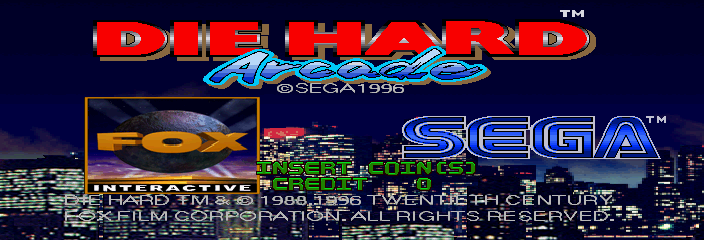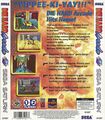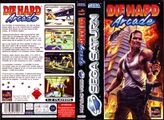Difference between revisions of "Die Hard Arcade"
From Sega Retro
m (→Arcade Version) |
|||
| Line 45: | Line 45: | ||
===Arcade Version=== | ===Arcade Version=== | ||
: '''Program Work''' | : '''Program Work''' | ||
| − | '''Chief Programmer:''' Hiroshi Ando<br> | + | '''Chief Programmer:''' [[Hiroshi Ando]]<br> |
'''Enemy Programmer:''' Masanobu Yamamoto<br> | '''Enemy Programmer:''' Masanobu Yamamoto<br> | ||
'''Sub Programmer:''' Teruji Abe<br> | '''Sub Programmer:''' Teruji Abe<br> | ||
| Line 54: | Line 54: | ||
'''Animation Artist:''' Dean Ruggles, Tom Tobey, [[Makoto Uchida]], Greg Hancock<br> | '''Animation Artist:''' Dean Ruggles, Tom Tobey, [[Makoto Uchida]], Greg Hancock<br> | ||
'''Back Ground Scr:''' Alan Ackerman<br> | '''Back Ground Scr:''' Alan Ackerman<br> | ||
| − | '''Illustrator:''' Tony De Zuniga<br> | + | '''Illustrator:''' [[Tony De Zuniga]]<br> |
'''Art Manager:''' [[Robert Steele|Bob Steele]]<br> | '''Art Manager:''' [[Robert Steele|Bob Steele]]<br> | ||
: '''Sound Work''' | : '''Sound Work''' | ||
'''Sound Director:''' [[Howard Drossin]]<br> | '''Sound Director:''' [[Howard Drossin]]<br> | ||
: '''Special Thanks'''<br> | : '''Special Thanks'''<br> | ||
| − | [[Hiro]], Paul Sears, Youichi Ueda, Robert Morgan, [[David Leytze]], Richard Hideshima, [[Tohru Nakabayashi]], Kouji Ooto, [[Yuko Isoda|Yuko L. Isoda]], | + | [[Hiro]], Paul Sears, [[Yuichi Ueda|Youichi Ueda]], Robert Morgan, [[David Leytze]], Richard Hideshima, [[Tohru Nakabayashi]], [[Koji Ooto|Kouji Ooto]], [[Yuko Isoda|Yuko L. Isoda]], [[Koji Tanuma|Kohji Tanuma]], Sachiko Amano, [[Masayuki Ao]], Naoko Takahashi, [[Susumu Hirai|Susumi Hirai]], Morikuni Kubo, [[Shinichiro Okumoto]], Masamoto Morita<br> |
'''Producer:''' [[Roger Hector]], [[Rikiya Nakagawa]], [[Makoto Uchida]]<br> | '''Producer:''' [[Roger Hector]], [[Rikiya Nakagawa]], [[Makoto Uchida]]<br> | ||
| − | '''Executive Producer:''' Hisashi Suzuki<br> | + | '''Executive Producer:''' [[Hisashi Suzuki]]<br> |
'''Game Design & Directed by:''' [[Makoto Uchida]]<br> | '''Game Design & Directed by:''' [[Makoto Uchida]]<br> | ||
Revision as of 20:48, 7 May 2012
| Die Hard Arcade | |||||
|---|---|---|---|---|---|
| System(s): Sega Titan Video, Sega Saturn | |||||
| Publisher: Sega | |||||
| Developer: Sega AM1, Sega Technical Institute | |||||
| Genre: Action | |||||
| |||||
Die Hard Arcade known as Dynamite Deka (ダイナマイト刑事) in Japan is an arcade beat-em up developed by both Sega AM1 and Sega Technical Institute. It was published by Sega for the Sega Titan Video arcade platform before being ported to the Sega Saturn in 1996 and 1997 respectively. It was the last title Sega Technical Institute worked on before it was dissolved.
Die Hard Arcade had its Die Hard license brought in very late within the game's development cycle and is completely absent in the Japanese release of Dynamite Deka. It is nevertheless clearly inspired by the first Die Hard movie (which in turn was inspired by a novel, Nothing Last Forever), taking place entirely within the confinds of a skyscraper. The male protagonist (known as Bruno Delinger in the Japanese version) also bears a slight resemblance to John McClane, the protagonist of the movie.
Contents
Gameplay
The game involves having to save the president's daughter from a group of terrorists who have taken over a skyscraper. As well as beat 'em up sections, there are also quick time events which can save the player the trouble of having to fight more opponents.
Sequels and Re-releases
When released on the Sega Saturn, the game came bundled with a version of Sega's 1979 arcade game Deep Scan. Each 200 points earned in Deep Scan gives the player credits in Die Hard Arcade.
Dynamite Deka was followed by Dynamite Deka 2 on the Dreamcast/Sega Model 2. This game was known as Dynamite Cop outside of Japan. The story would be continued in Dynamite Deka EX, also known as Asian Dynamite, and the game would be remade in the form of Sega Ages 2500 Series Vol. 26: Dynamite Deka.
Production Credits
Arcade Version
- Program Work
Chief Programmer: Hiroshi Ando
Enemy Programmer: Masanobu Yamamoto
Sub Programmer: Teruji Abe
- Art Work
Chief Artist: Kunitake Aoki, Tatsuto Kumada
Model Artist: Joe Stephenson, Stieg Hedlund, Andrew Mundy, Betty Cunningham
Player Model Artist: Taku Makino, Yoshiaki Aoki, Hideyuki Katoh
Animation Artist: Dean Ruggles, Tom Tobey, Makoto Uchida, Greg Hancock
Back Ground Scr: Alan Ackerman
Illustrator: Tony De Zuniga
Art Manager: Bob Steele
- Sound Work
Sound Director: Howard Drossin
- Special Thanks
Hiro, Paul Sears, Youichi Ueda, Robert Morgan, David Leytze, Richard Hideshima, Tohru Nakabayashi, Kouji Ooto, Yuko L. Isoda, Kohji Tanuma, Sachiko Amano, Masayuki Ao, Naoko Takahashi, Susumi Hirai, Morikuni Kubo, Shinichiro Okumoto, Masamoto Morita
Producer: Roger Hector, Rikiya Nakagawa, Makoto Uchida
Executive Producer: Hisashi Suzuki
Game Design & Directed by: Makoto Uchida
Physical Scans
Sega Titan Video Version
Saturn Version
| Sega Retro Average | ||||||||||||||||||||||||||||||||||||||||||||||||||||||||||||||||||||||||||||||||||||||||||||||||||||||||||||||||||||||||||||||||||||||||||||||||||||||||||||||||||||
|---|---|---|---|---|---|---|---|---|---|---|---|---|---|---|---|---|---|---|---|---|---|---|---|---|---|---|---|---|---|---|---|---|---|---|---|---|---|---|---|---|---|---|---|---|---|---|---|---|---|---|---|---|---|---|---|---|---|---|---|---|---|---|---|---|---|---|---|---|---|---|---|---|---|---|---|---|---|---|---|---|---|---|---|---|---|---|---|---|---|---|---|---|---|---|---|---|---|---|---|---|---|---|---|---|---|---|---|---|---|---|---|---|---|---|---|---|---|---|---|---|---|---|---|---|---|---|---|---|---|---|---|---|---|---|---|---|---|---|---|---|---|---|---|---|---|---|---|---|---|---|---|---|---|---|---|---|---|---|---|---|---|---|---|---|
|
| 77 | |
|---|---|
| Based on 32 reviews | |
| Saturn, JP |
|---|
50x50px Disc |
- ↑ 576 KByte, "Szeptember 1997" (HU; 1997-xx-xx), page 16
- ↑ Ação Games, "Maio 1997" (BR; 1997-xx-xx), page 20
- ↑ CD Consoles, "Avril 1997" (FR; 1997-xx-xx), page 84
- ↑ Console Mania, "Marzo 1997" (IT; 1997-0x-xx), page 46
- ↑ Computer & Video Games, "March 1997" (UK; 1997-02-12), page 74
- ↑ Edge, "March 1997" (UK; 1997-02-28), page 78
- ↑ Electronic Gaming Monthly, "April 1997" (US; 1997-0x-xx), page 53
- ↑ Famitsu, "1997-01-31" (JP; 1997-01-17), page 1
- ↑ Freak, "4/97" (IL; 1997-xx-xx), page 1
- ↑ Fun Generation, "03/97" (DE; 1997-02-12), page 74
- ↑ Gambler, "6/1997" (PL; 1997-xx-xx), page 1
- ↑ GameFan, "Volume 5, Issue 4: April 1997" (US; 1997-xx-xx), page 26
- ↑ GamePro, "April 1997" (US; 1997-xx-xx), page 90
- ↑ Game Informer, "March 1997" (US; 1997-0x-xx), page 42
- ↑ Gry Komputerowe, "6/1997" (PL; 1997-xx-xx), page 1
- ↑ MAN!AC, "03/97" (DE; 1997-02-12), page 70
- ↑ Mega Fun, "03/97" (DE; 1997-02-05), page 88
- ↑ Next Generation, "April 1997" (US; 1997-03-11), page 126
- ↑ neXt Level, "März 1997" (DE; 1997-02-21), page 68
- ↑ Player One, "Mars 1997" (FR; 1997-xx-xx), page 64
- ↑ Saturn Fan, "1997 No. 2" (JP; 1997-01-17), page 185
- ↑ Saturn Fan, "1997 No. 5" (JP; 1997-02-28), page 98
- ↑ Secret Service, "Kwiecień 1997" (PL; 1997-xx-xx), page 64
- ↑ Sega Magazin, "März 1997" (DE; 1997-02-12), page 26
- ↑ Sega Power, "March 1997" (UK; 1997-02-12), page 38
- ↑ Sega Saturn Magazine, "March 1997" (UK; 1997-02-19), page 62
- ↑ Sega Saturn Magazine, "1997-02 (1997-01-31)" (JP; 1997-01-17), page 222
- ↑ Sega Saturn Magazine, "Readers rating final data" (JP; 2000-03), page 13
- ↑ Strana Igr, "May 1997" (RU; 1997-xx-xx), page 81
- ↑ Super Power, "4 1997" (FI; 1997-0x-xx), page 48
- ↑ Ultra Game Players, "April 1997" (US; 1997-03-25), page 69
- ↑ Video Games, "3/97" (DE; 1997-02-19), page 96








